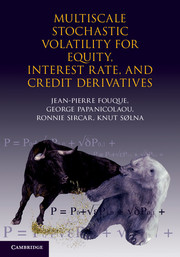Book contents
- Frontmatter
- Contents
- Introduction
- 1 The Black–Scholes Theory of Derivative Pricing
- 2 Introduction to Stochastic Volatility Models
- 3 Volatility Time Scales
- 4 First-Order Perturbation Theory
- 5 Implied Volatility Formulas and Calibration
- 6 Application to Exotic Derivatives
- 7 Application to American Derivatives
- 8 Hedging Strategies
- 9 Extensions
- 10 Around the Heston Model
- 11 Other Applications
- 12 Interest Rate Models
- 13 Credit Risk I: Structural Models with Stochastic Volatility
- 14 Credit Risk II: Multiscale Intensity-Based Models
- 15 Epilogue
- References
- Index
8 - Hedging Strategies
Published online by Cambridge University Press: 07 October 2011
- Frontmatter
- Contents
- Introduction
- 1 The Black–Scholes Theory of Derivative Pricing
- 2 Introduction to Stochastic Volatility Models
- 3 Volatility Time Scales
- 4 First-Order Perturbation Theory
- 5 Implied Volatility Formulas and Calibration
- 6 Application to Exotic Derivatives
- 7 Application to American Derivatives
- 8 Hedging Strategies
- 9 Extensions
- 10 Around the Heston Model
- 11 Other Applications
- 12 Interest Rate Models
- 13 Credit Risk I: Structural Models with Stochastic Volatility
- 14 Credit Risk II: Multiscale Intensity-Based Models
- 15 Epilogue
- References
- Index
Summary
In this chapter, we look at how the perturbation analysis helps with the risk management problem of hedging a derivative position. As discussed at the end of Section 2.4.2, financial institutions often want to eliminate or reduce their exposure to a contingent claim written on an asset by trading in the underlying asset. In an incomplete market, a perfect hedge is not possible and the goal is to find an acceptable tradeoff between the risk of a failed hedge and the cost of implementing the hedge. The statistical performance of a strategy is measured by the investor's subjective probability ℙ.
In the first section we briefly recall the Black–Scholes Delta hedging strategy under constant volatility. In Section 8.2 we compute the cost of the same strategy under stochastic volatility driven by a fast and a slow factor. The perturbation method enables us to identify the first-order terms of the cost in (8.13). In Section 8.3 we propose to correct the hedging ratio in such a way that cost become unbiased with a reduced variance. The strategy requires dynamically estimating the effective volatility from historical returns data, and dynamically calibrating the correction parameters from implied volatility data. In Section 8.4 we propose a more practical strategy which consists of using frozen parameters estimated at time zero, and we quantify the additional cost. Even though the parameters are frozen, the strategy still requires a continuous dynamic hedging and the problem of transaction cost is not addressed here.
- Type
- Chapter
- Information
- Publisher: Cambridge University PressPrint publication year: 2011

